
WHAT’S AT STAKE:
FISH
The Mississippi River Delta’s estuaries and wetlands provide nurseries and spawning grounds for huge numbers of aquatic organisms, from commercially important seafood species (crawfish, shrimp, blue crabs, menhaden, drum and others) to alligator gar, paddlefish and the endangered pallid sturgeon. The delta’s once-great oyster reefs are today significantly reduced but still provide an important resource for other wildlife and for humans alike.
Learn more about different species below.
INSHORE FISH
These species will be most affected by coastal restoration as they inhabit, feed and spawn in the wetlands that will benefit from restoration projects.
-

Redfish (Red Drum, Bull Red)
A widely sought-after recreational fish, the redfish can vary from an iridescent coppery black to a reddish copper tone. It is most identifiable by the black spot located near the tail fin.
- Average Size: 4 to 5 pounds
- Habitat: Redfish are adaptable to varying levels of salinity and may be found from fresh water zones out to 50 feet offshore. They prey on crab, shrimp and smaller fish and can be found from soft mud bottoms feeding on submerged vegetation to oyster bottoms and near oil rig platforms.
- Limits: Recreational fishermen in Louisiana may take up to 5 redfish a day measuring 16-27 inches total max length. Only one redfish over 27 inches may be harvested a day.
-

Black Drum
A close cousin to the redfish, the black drum is often harvested recreationally for its exceptional taste. It ranges in color from silver in the deep Gulf waters to a dark black in shallower muddy estuaries. The fish is recognized by its 12-13 “whiskers” below its lower jaw, and by the vertical stripes down its back which fade as the fish age. Since oysters are a main food source for the black drum, they have teeth at the back of their throat which are used for crushing.
- Average Size: 5-30 pounds, although it is not uncommon to catch a black drum weighing more than 50 pounds.
- Habitat: The black drum can be found from brackish waters to nearshore waters of the Gulf. They tend to aggregate around structures like oyster reefs.
- Limits: Recreational fishermen in Louisiana may take 5 black drum per day ranging from 16-27 inches in total length with no more than one above 27 inches.
-
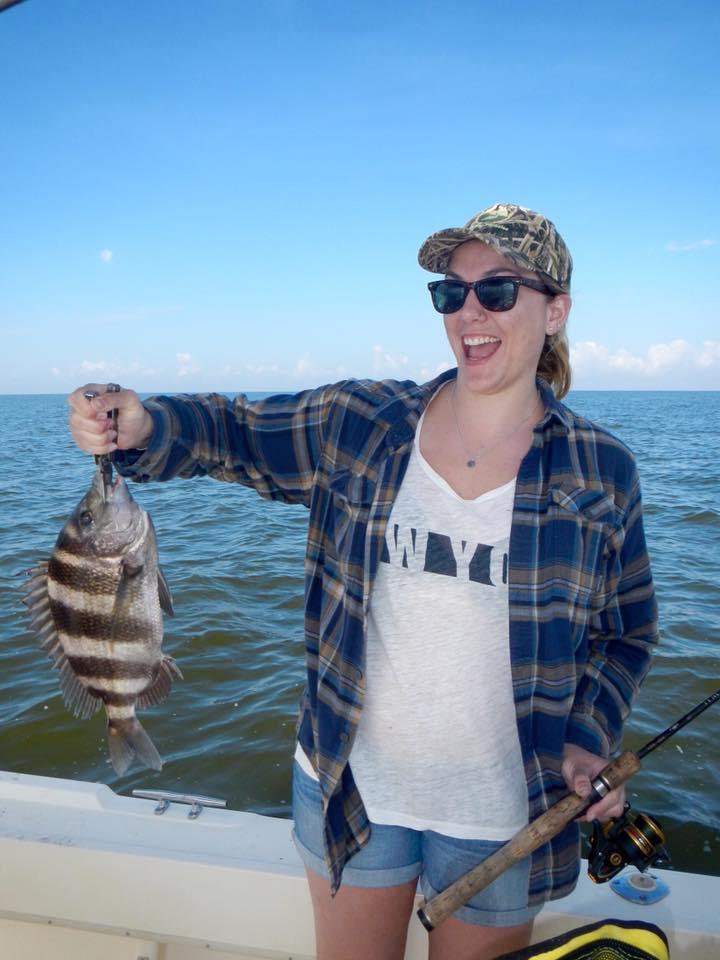
Sheepshead
Ranging from greenish gray to dark silver with seven vertical stripes on its side, the sheepshead is commonly mistaken for the black drum. But on second looks, the sheepshead is easily distinguishable by its human-like teeth — including incisors and molars. Its teeth make crushing their prey of oysters, blue crab, clams and barnacles.
- Average size: 14 to 18 inches, and 1 to 8 pounds.
- Habitat: Sheepshead prefer brackish inshore waters, but may adapt to varying salinities.
- Limits: There are currently no recreational limit regulations on sheepshead harvest.
-
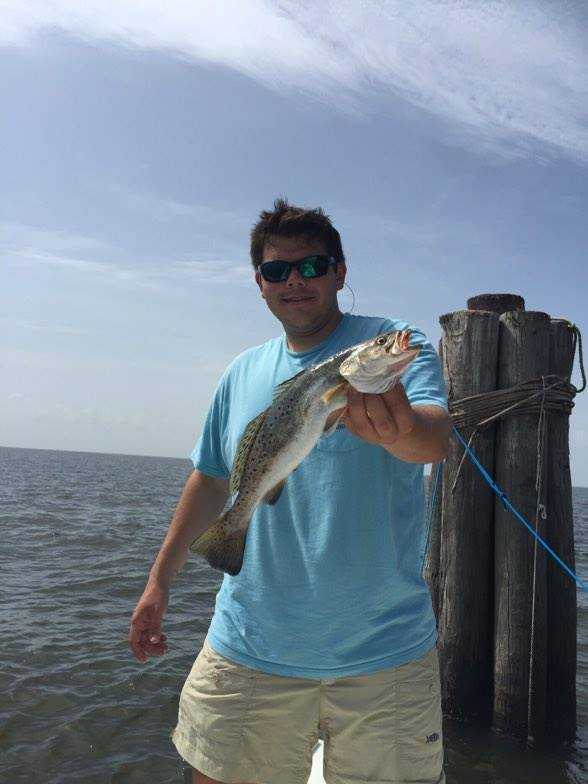
Spotted Sea Trout (Speckled Trout)
The most sought-after species by in and near shore anglers, speckled trout have iridescent, dark gray or yellow to greenish sides with white bellies. They are often distinguished by their round dark spots on their back and tail.
- Average size: The male also reaches max length at 19 inches, and the female may grow to 25 inches. Speckled trout may reach up to 15 pounds, but are most commonly harvested around 4 pounds.
- Habitat: Speckled trout migrate throughout the year to spawn and feed. They are often found in still, deep water in the winter, and then move further into the saltier shallow waters of the Gulf in the spring and summer. They prefer brackish to saltwater estuaries, and are often found in sea grass beds, oyster reefs, and other shallow water habitats. Speckled trout are opportunistic feeders, preying on anything from small crustaceans like shrimp to small fish such as the mullet.
- Limits: In Louisiana, an angler may take up to 25 a day with a minimum length of 12 inches.
-
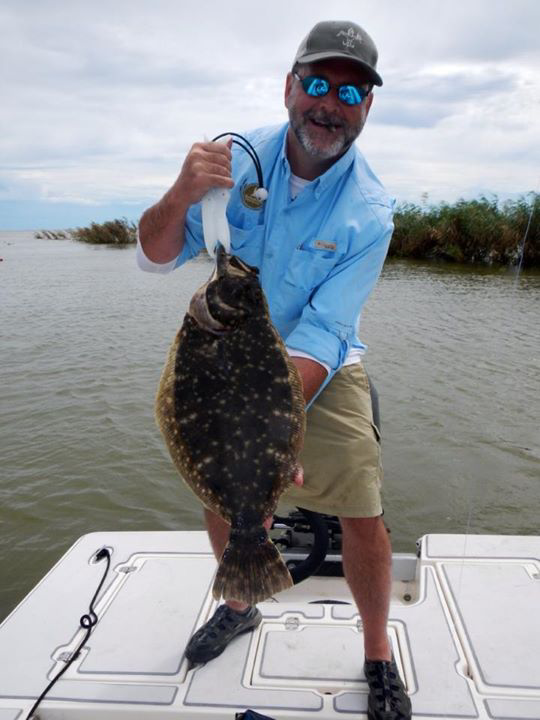
Southern Flounder
This unique fish is a flat oval-shaped fish that spends its life traveling on the bottom of the estuary. The under belly of the fish is white, while the top is brown with light and dark spots. The flounder may change its appearance to match its habitat, making it nearly impossible to spot in a muddied bottom environment. Unlike most fish, both eyes of the flounder are found on its upright side.
- Average size: Flounder may grow up to 3 feet long and weigh in as large as twenty pounds, but are normally harvested between the one to five pound weight ranges.
- Habitat: The Southern Flounder is found inshore in shallow waters with grassy to muddy bottoms. Flounder feed on small shrimp as well as menhaden and small mullet.
- Limits: An angler may take up to ten flounder a day, with no size regulations.
OFFSHORE FISH
An angler may leave a marina in many places along the Gulf Coast and target several offshore species. Due to the connectivity of the northern Gulf of Mexico, these species also benefit from comprehensive habitat restoration.
-

Snapper
There are many types of snapper anglers target along the Gulf — Lane, Mutton, Vermillion, Mangrove and the most popular, the Red Snapper.
A popular target due to its excellent texture and flavor, the red snapper is highly regulated.
- Average size: An average red snapper may weigh one to 30 pounds.
- Habitat: Snapper are reef fish and tend to aggregate in rocky bottom environments and oil rig platforms.
- Limits: Seasons within the state border (out to 9 miles) for the red snapper are set by the Louisiana Department of Wildlife and Fisheries. Snapper in state waters in managed by the department, and the commission may open and close the season to match the quote for the year. Red snapper season out of state waters is federally managed and regulated. The daily limit for red snapper is currently 2 per angler with a minimum total length of 16 inches.
-

Tuna
There are many types of tuna anglers target along the Gulf — Bluefin, Blackfin, Bigeye and the most popular, Yellowfin.
This cold-blooded delicacy is one of the fastest swimmers in the Gulf. The yellowfin tuna has a metallic, deep-blue back with a yellow ridged band extending down its back.
- Average size: Yellowfin are the among the largest of the species and can easily reach well over 100 pounds, often reach over 200 pounds and can tip the scales at 400 pounds.
- Habitat: Tuna may be found around oil platforms or near floating debris and vegetation in the open ocean.
- Limits: The current limit on Yellowfin is 3 daily per angler with a minimum total length of 27 inches.
-
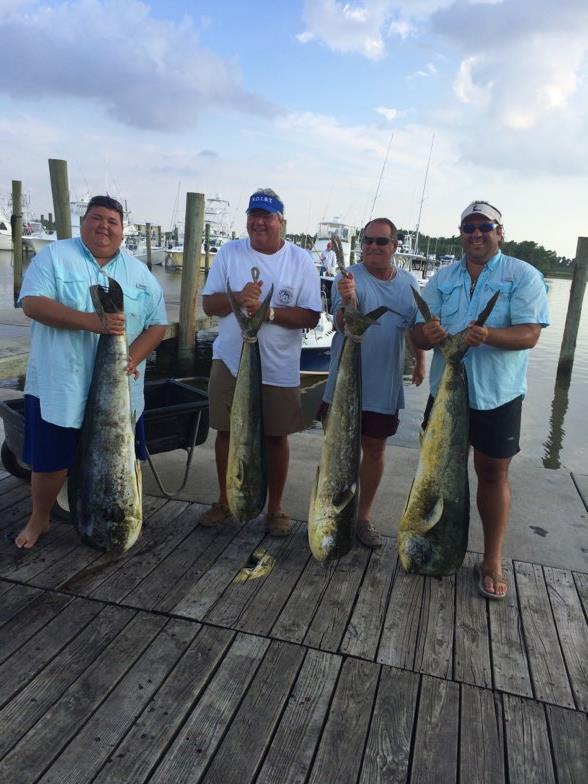
Mahi Mahi (Dolphin)
The mahi mahi is perhaps one of the most colorful and unique species that Gulf anglers target. The azure blue and emerald bodies of the fish quickly fade after their harvest. They are one of the fastest growers in the Gulf, and scientists can measure their growth daily.
- Average size: Mahi mahi may range from 3-20 pounds with adult males reaching up to 50 pounds.
- Habitat: Dolphins are found in open Gulf water near rips (floating patches of seaweed) and other floating debris.
-

Cobia (Lemonfish)
Cobia have dark brown bodies with white bellies, and when viewed from above or in the water, often resemble a shark due to their finlets.
- Average size: The most common size for Cobia is in the 50 pounds range, but it is not uncommon to find them around 80 pounds. It is considered rare to reel in a cobia weighing over 100 pounds.
- Habitat: Cobia can be found from high-salinity bays out to waters of depths reaching 250 feet. Cobia are attracted to structure like oil platforms, floating debris, and seaweed rips.
- Limits: An angler may take 2 cobia per day with a minimum fork length of 33 inches.
-
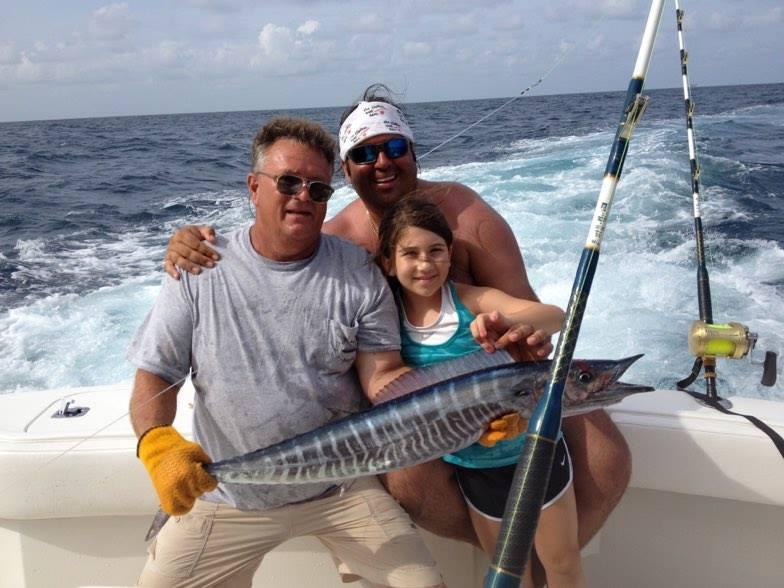
Wahoo
Wahoo are prized sport fish due to their taste, speed (swimming up to 60 mph!), and the fight they put up. The body of the Wahoo is a blue green color, and very streamlined which makes them great fast swimmers.
- Average size: Wahoo may reach between 50-75 pounds, but may be found up to 100 pounds.
- Habitat: Wahoo are known to be found around seaweed rips.
-

Grouper
Gulf anglers may target Black, Gag, Red, Warsaw and Scamp Grouper. The most common catch is the Gag Grouper.
The Gag Grouper is a dark brown fish, with pattern marking that resemble “kiss-like” shapes.
- Average size: This fish is commonly found ranging from 10-20 pounds, but may reach weights exceeding 50 pounds.
- Habitat: Grouper tend to aggregate themselves around structure like rock and reef bottoms, or oil and gas platforms. They are found in depths ranging from 60-250 feet of water, with larger grouper being found on the deeper end of that spectrum.
- Limits: In Louisiana, an angler may take 4 Gag Grouper a day with a minimum total length of 24 inches per fish.
FRESHWATER
More freshwater inflow from coastal restoration projects means more freshwater fish to harvest.
-
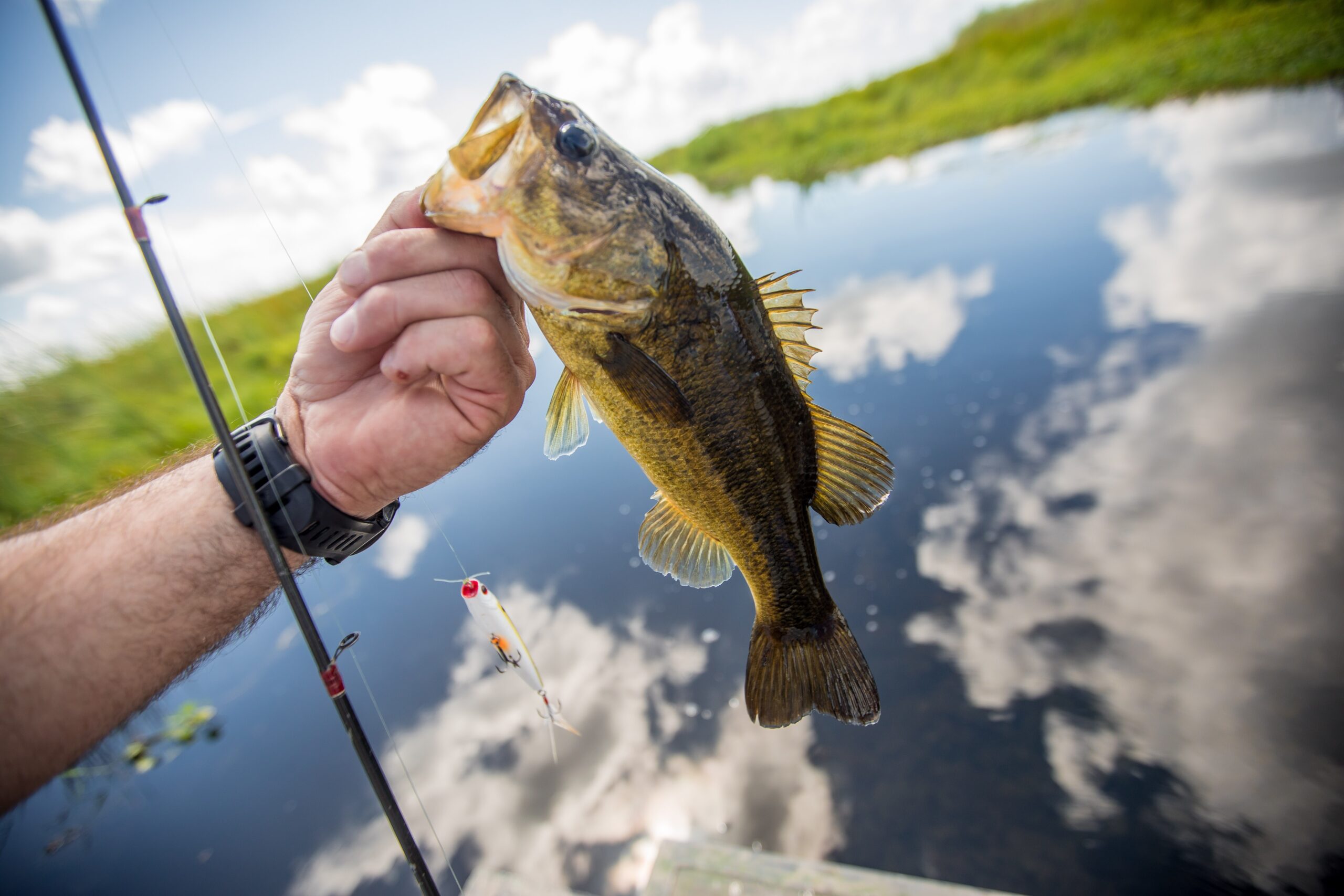
Bass (Largemouth bass)
The number one recreationally targeted fish species, bass are usually a dark olive green fish with dark patches that form a horizontal line along the middle of the body. The fish has a lighter green to white under belly. Bass are the dominant predator in a freshwater environment, feeding on anything from crawfish to small fish including smaller bass, to snakes and frogs.
- Average size: Bass may grow up to 16 inches. An angler may expect to catch a large mouth weighing in around 3 pounds and measuring at 18 inches, but they may grow up to 24 inches.
- Habitat: They seek cover in logs or man-made structures, and prefer quiet calm water, but may adapt to a variety of habitats.
-

Crappie (Sac a Lait)
Officially declared Louisiana’s state freshwater fish, the sac a lait comes in two varieties: white and black. Both species exist together and are commonly caught in the same place. Black crappie are darker in color with black spots scattered randomly across the sides of the fish. In white crappie, the black spots are more arranged in vertical stripes or bars on the sides of the body. Both species prey on small insects, river shrimp, minnows, and other small fish.
- Average size: Most crappie range from a half of pound to one pound.
- Habitat: White crappie prefer moving water and are often found in more turbid muddier places than the black crappie. The black crappie often prefers clear, still swamp waters. Both species will be found taking cover in logs and old tree stumps.
-
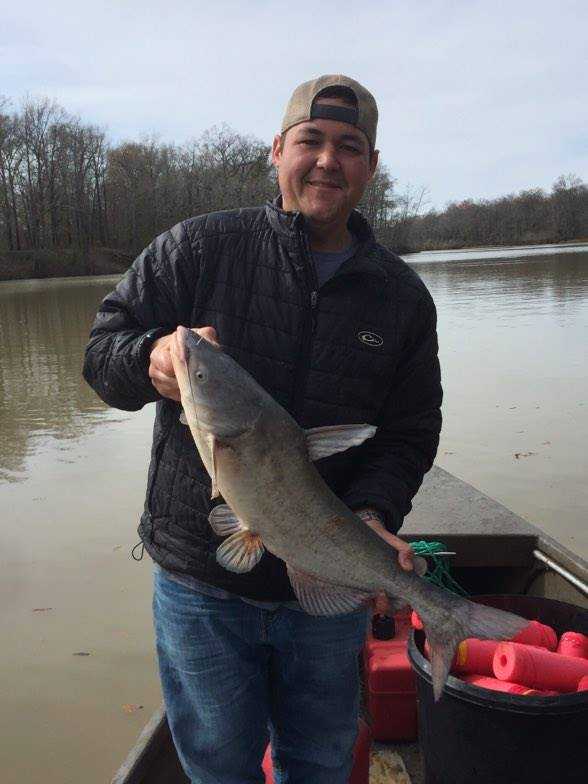
Catfish
The three most sought-after species are the blue catfish, channel catfish, and the flathead catfish.
The blue catfish is Louisiana’s largest freshwater game species. The blues and channel cats eat a wide variety from insects to plant matter to river shrimp. Coastal blues have even been found with small nutria in their stomachs. Whereas, the flathead is primarily a predator feeding mainly on live fish. These fine table fish will become more prevalent in our estuarine areas due to freshwater inflow from coastal restoration projects.
Sources: LSU Sea Grant, Louisiana Department of Wildlife and Fisheries (LDWF), and Gulffishinfo.org.